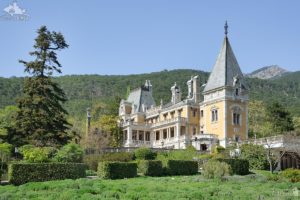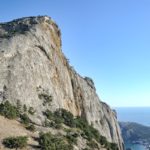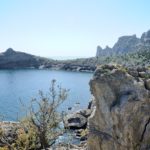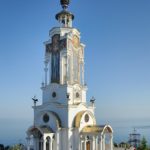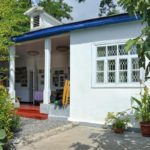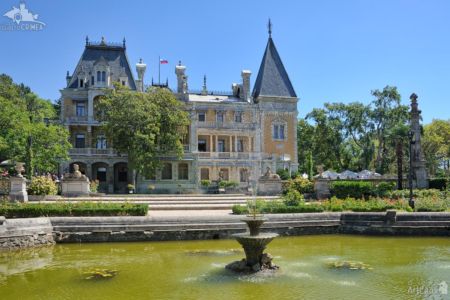
The construction of the Massandra Palace began in 1879. Since then, the estate has changed owners at least 4 times, but no one has ever actually lived in the castle. There has never been a comprehensive reconstruction of the facades, therefore, the palace has been preserved in its original form both inside and out. Massandra Palace is now a museum dedicated to the reign of the Romanovs, and the exhibits present the original artifacts that were made by potters, stone-cutters, furniture makers and woodcarvers commissioned by the Imperial Court.
Inside you can see that all the rooms, including classrooms, a bedchamber, a billiard room, and a library, look quite habitable, nevertheless, neither the original owners who implemented the original construction had time to live in this residence, and those who subsequently owned the palace did not like it, despite the fact that it is a fabulous and majestic building. The story behind the imperial residence in Massandra is therefore quite interesting.
Owners of the Massandra Palace
In 1879, Semyon Vorontsov, the son of the Governor-General of New Russia, commissioned the French architect Etienne Bouchard to construct a magnificent castle with two central towers, a design that was similar to French castles located in the Loire Valley. Unfortunately, the architect died, and for several years no one was interested in the palace until it was bought for Alexander III.
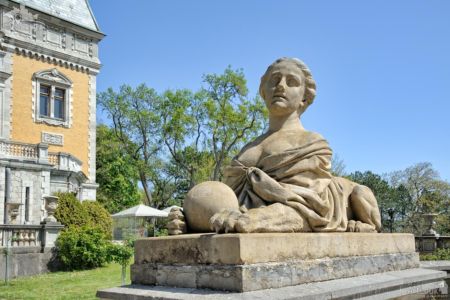
Front angle view of a sculpture of the woman-sphinx with a ball at Southern facade of Massandra Palace.
The emperor liked the idea of building a castle in the French style and invited the talented Russian architect (of German ancestry) Maximilian Egorovich Messmacher (also known as Maximilian von Messmacher) to continue the construction. Messmacher’s design was reminiscent of a French chateau, being less austere, and with the addition of many windows, turrets, and spires. The resulting building was an excellent example of other royal castles built in the style of the storyteller Charles Perrault. Nevertheless, the original source of inspiration, the castles of the French aristocracy from the Valais de la Loire, is clearly traceable.
Following the death of Emperor Alexander, the palace was opened to the public. The furniture was created specifically for public visits, so the palace has no common interior design concept, but a mix of several different styles.
Nicholas II loved to walk around Massandra, came to the area primarily for hunting, but stopped in the palace itself only once, when it was necessary to spend the night on the road.
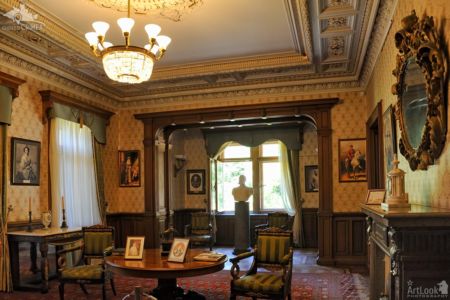
After many years, the palace became a state summer residence and the “property” of Joseph Stalin. At this time workers at the palace removed the original satyrs from the fences, replacing their heads with lions, because they considered that their “leader” would not like the original sculptures. However, Stalin did not like the Massandra Palace (possibly because of his hatred of imperial luxury), and therefore his cottage was more ascetic and protected.
Modern Exposition
The facades of the building still look as magnificent as they did after their original construction. The scaly roof of layered graphite, made according to old, already forgotten, French technology, has been well preserved. The palace is “guarded” by a satyr playing the flute and two statues of sphinx-like women with balls.
In the castle, you can see the chambers of the emperor and empress, and their fully equipped cabinets with preserved fireplaces. Local Crimean brown marble was used for the fireplaces, and the masters used solid pieces of stone for the portals.
The interior decorations, such as vases, frames, candlesticks, dominate the Baroque and Rococo styles.

Around the palace, a magnificent park with fountains has been preserved. The park covers an area of almost 40 hectares. Unconditional decorations of this park are two giant evergreen sequoias (sequoiadendron giganteum), the highest mammoth trees in the Crimea. The trees were planted on the western facade of the Massandra Palace 130 years ago when Messmacher was involved in the project during the 1890s. At the present time, the approximate girth of the giant sequoias is roughly nine meters, and the height around forty meters. The Nikitsky Botanical Garden received the seeds for these trees in 1840 from the former Russian colony Ross in California.

The museum in the Massandra Palace provides an opportunity for the public to view the life of the imperial family, and to appreciate those things the Romanovs loved to surround themselves with, and to feel the atmosphere of that era.
The story of the palace is also written in the present, and on June 1st, 2017, a bronze bust commissioned from the sculptor Apollonov, was unveiled to commemorate the life of Tsar Alexander III The Peacemaker. The event also commemorated the 175 year anniversary of the birth of the palace architect Maximilian Messmacher; the 135 year anniversary of the founding of the Imperial Orthodox Palestinian Society and the 25 year anniversary of the opening of the Massandra Palace as a museum.
Address and Opening Hours
Simferopolskoe sh., 13, Masandra
Every day from 08:00-19:00 (July, August, mid of September); 09:00 to 18:00 (April, May, June, mid of September, October); 09:00 to 17:00 (January, February, March, November, December)
Photographs from the Tour

Interior decoration of the Billiard room of Massandra Palace with the beautiful chandelier and fragment of stucco ceiling with Gothic forms. Following 19th century interior rules, the Billiard room was finished in the style of the English Renaissance.
Photo #096 taken on May 02, 2017
| Album | Massandra Estate |
| Category | Interior |
| Taken | May 2, 2017 |
| Uploaded | November 2, 2019 |
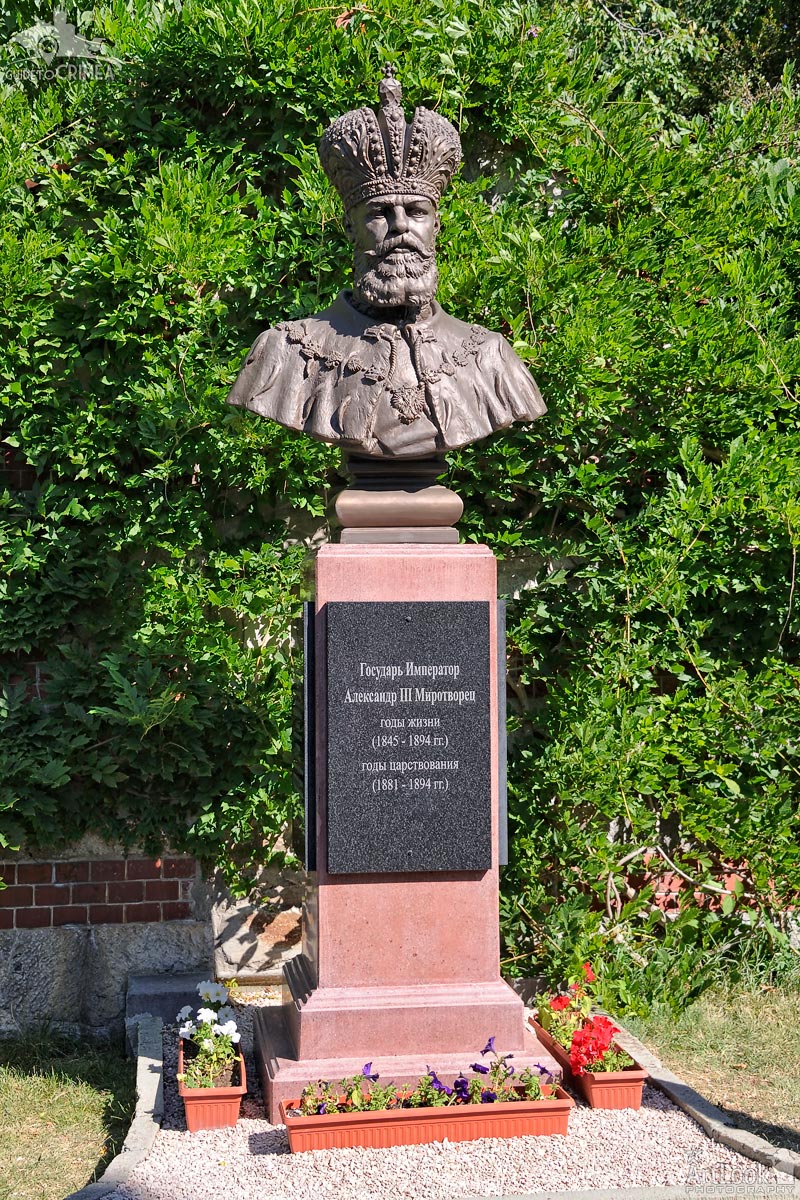
Bust of Russian Emperor Alexander III (years of life 1845-1894) at the Massandra Palace in Crimea. During Alexander’s reign (1881-1894) the country was not involved in major wars, so that is why he was called by all people of Russia "The Peacemaker". He was a man of amazing fortitude, beauty, and harmony, courage and devotion to his Fatherland.
The grand opening ceremonial and consecration of the bust took place on the grounds of the former estate of Alexander III in Massandra on June 1st, 2017. The event was timed to such anniversaries as 175 years since the birth of the palace architect Maximilian Mesmacher, 135 years since the founding of the Imperial Orthodox Palestinian Society and 25 years since the beginning of the work of the Massandra Palace as a museum.
Photo #027 taken on August 13, 2019 during visiting Massandra Palace with my Dear clients from Hong Kong, Esther and Ricky on the 3rd day of the adventure trip “Discovering Crimea in 6 Days”.
| Album | Massandra Estate |
| Category | Art Works |
| Taken | August 13, 2019 |
| Uploaded | October 22, 2019 |
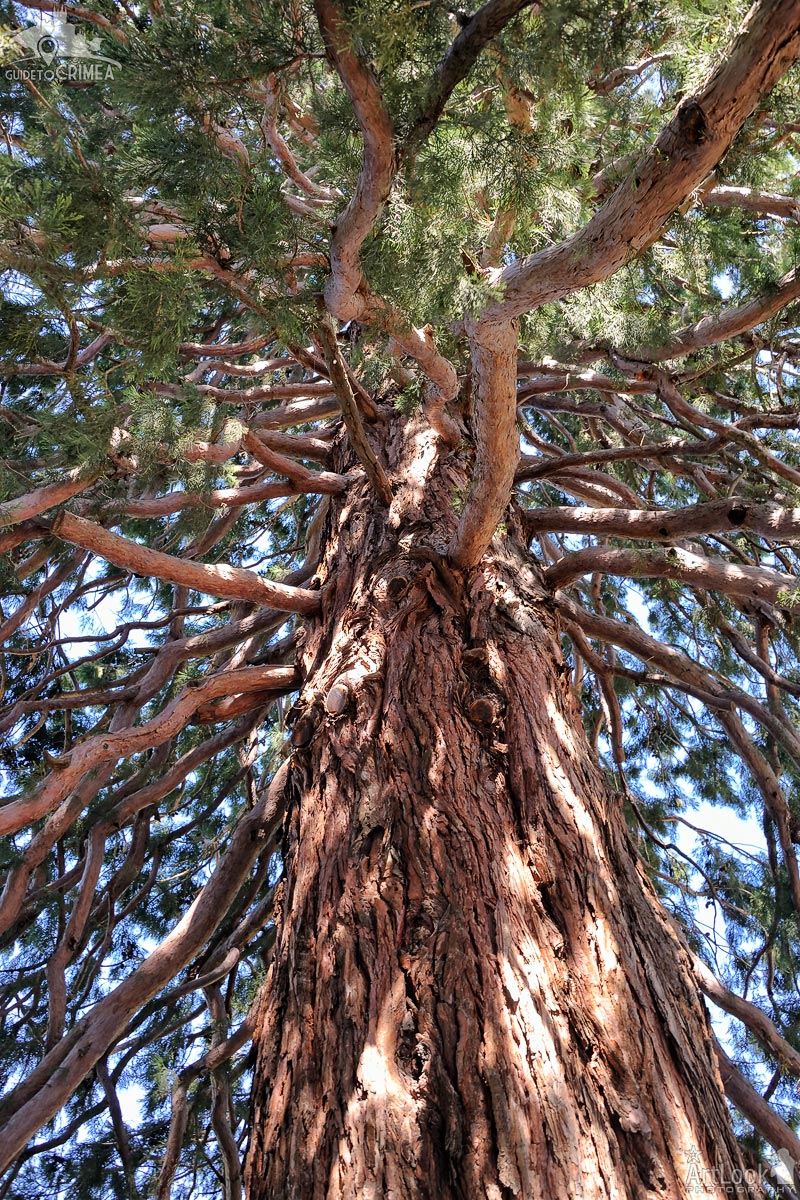
Looking up through the branches of a Sequoiadendron giganteum in Massandra park. Its branches resembling mammoth tusks, that is why this type of sequoias called Mammoth tree. This giant tree was planted at the western facade of the Massandra Palace 130 years ago during the reconstruction of the residence of Emperor Alexander III according to the project of the famous architect Messmacher in the 1890s. In the present time, the trunk girth of the sequoiadendron is about nine meters, and the height is about forty meters.
Photo #172 taken on August 13, 2019 during visiting Massandra Palace with my dear clients from Hong Kong, Esther and Ricky on the 3rd day of the adventure trip “Discovering Crimea in 6 Days”.
| Album | Massandra Estate |
| Category | Nature |
| Taken | August 13, 2019 |
| Uploaded | October 29, 2019 |

Angle view of the interior of the Cabinet of His Imperial Majesty in Massandra Palace made by the tradition of classicism. Molded elements with gilding are successfully implemented in the strict ceiling design (master M. A. Zhilkin). The useful area of the cabinet was increased due to a niche at the northern facade of the palace. Niche, doors, panels are made of walnut, in harmony with the fireplace, lined with gray marble (at the right). Items of furniture and arts and crafts are typical for palace interiors at the turn of the XIX-XX centuries.
A sculpture of the horse of the German master Slodenbek (Berlin, beginning of the XX century) is placed on a round table with a carved table stand (the work of Russian masters of the late XIX century) in the middle of the cabinet. Armchairs around the table by Russian masters of the first third of the 19th century in the Empire style are ornamented with gilded woodcarvings in the form of laurel wreaths, garlands, stylized military armor. In the depths of the niche is a marble bust of Emperor Alexander II (1818-1881), the sovereign reformer, made by an unknown sculptor in the early 60s of XIX century.
Photo #084 taken on August 13, 2019 during visiting Massandra Palace with my dear clients from Hong Kong, Esther and Ricky on the 3rd day of the adventure trip “Discovering Crimea in 6 Days”.
| Album | Massandra Estate |
| Category | Architectural |
| Taken | August 13, 2019 |
| Uploaded | October 23, 2019 |

The reception rooms and offices of Their Majesties are located on the second floor of Massandra Palace, as well as their bedchamber and bathrooms. Conventionally, the entire floor of the castle can be divided into two halves - male and female, and each of them has a spiral staircase at the left and right sides of the building.
On the picture is shown decorations of ceiling in reception room of Maria Fedorovna. The finest molding of the ceiling is painted that allows to examine its ornament. Artfully mounted in the ceiling lattices of ventilation system was made by the project of Professor Lukashevich. The interior of reception room supplemented with nice bronze chandelier.
Photo #126 taken on September 14, 2013
| Album | Massandra Estate |
| Category | Interior |
| Taken | September 14, 2013 |
| Uploaded | October 30, 2019 |

The working fountain in a beautiful park in front of Massandra Palace on a nice sunny morning.
The Palace in Massandra resembling a French chateau was built in 1881-1900 for Tsar Alexander III, but after his death in 1894, it was finished in 1900 by his son and the last Russian Tsar, Nicolas II. The castle is located on elevated and cliffy cape. It was used by Romanovs only as a hunting lodge and the royal family never stayed for a night here, but during the Soviet times, Joseph Stalin decided to use it as his dacha in Crimea.
Photo #174 taken on August 13, 2019 during visiting Massandra Palace with my dear clients from Hong Kong, Esther and Ricky on the 3rd day of the adventure trip “Discovering Crimea in 6 Days”.
| Album | Massandra Estate |
| Category | Architectural |
| Taken | August 13, 2019 |
| Uploaded | October 22, 2019 |
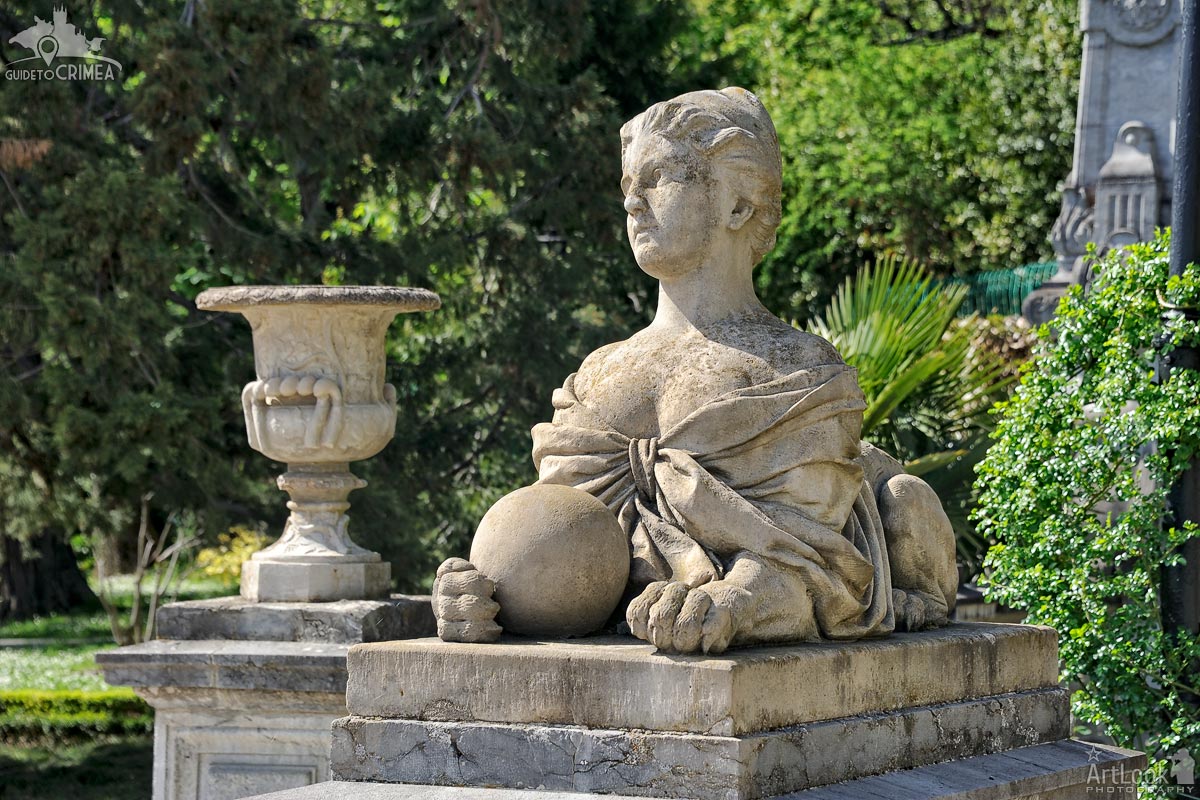
Sculpture of the woman-sphinx with a ball at the facade of Massandra Palace, a suburb of Yalta, Crimea. The palace was built at the end of 19th century in the style of Louis XIII of France (French chateaux of the Renaissance) and belonged to Russian Emperor Alexander III.
Photo #227 taken on May 02, 2017
| Album | Massandra Estate |
| Categories | Architectural, Art Works |
| Taken | May 2, 2017 |
| Uploaded | October 30, 2019 |
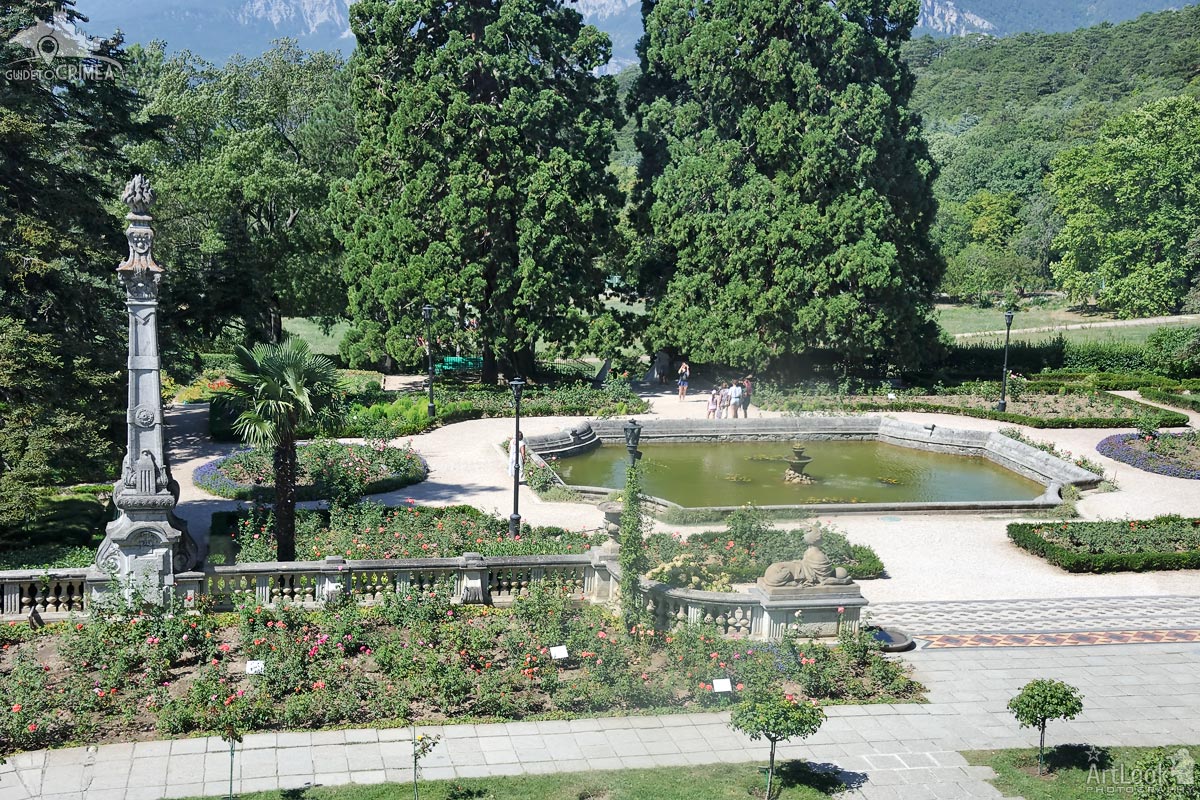
Looking on the splendid park with fountain, sculptures, and columns from a window on the second floor at the south-western side of Massandra Palace. This beautiful park was developed in a French style during the reconstruction of the palace, the summer residence of Alexander III in Crimea, by the project of Messmacher in the 1890s. Behind the fountain are growing two giant sequoias (Sequoiadendron Giganteum), the highest mammoth trees in Crimea. They were planted 130 years ago, so in the present time, the trunk girth of these trees is about nine meters, and the height is about forty meters.
Photo #136 taken on August 13, 2019 during the tour of Massandra Palace with my dear clients from Hong Kong, Esther and Ricky on the 3rd day of the adventure trip “Discovering Crimea in 6 Days”.
| Album | Massandra Estate |
| Categories | Architectural, Landscapes |
| Taken | August 13, 2019 |
| Uploaded | October 30, 2019 |
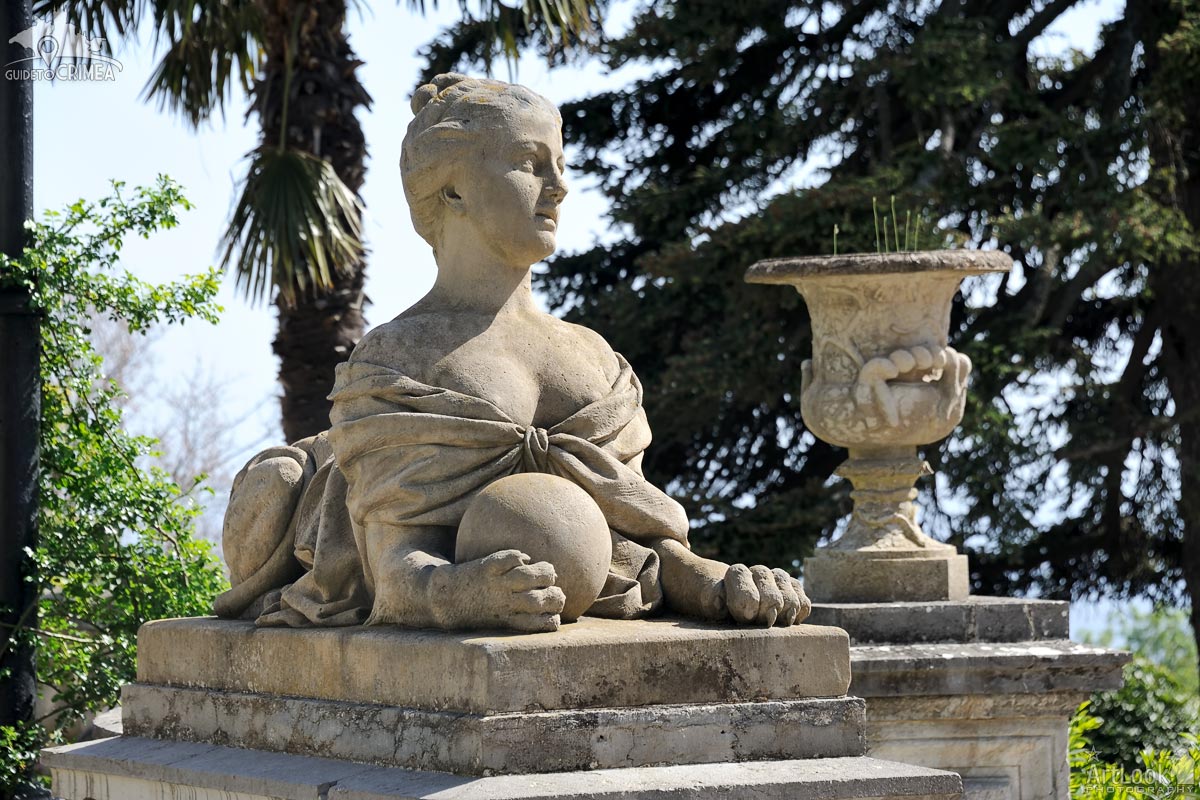
Sculpture of a woman-sphinx with a ball at Southern facade of Massandra Palace near Yalta, Crimea. The palace was built at the end of 19th century in the style of Louis XIII of France (French chateaux of the Renaissance) and belonged to Russian Emperor Alexander III.
Photo #226 taken on May 02, 2017
| Album | Massandra Estate |
| Category | Architectural |
| Taken | May 2, 2017 |
| Uploaded | October 29, 2019 |
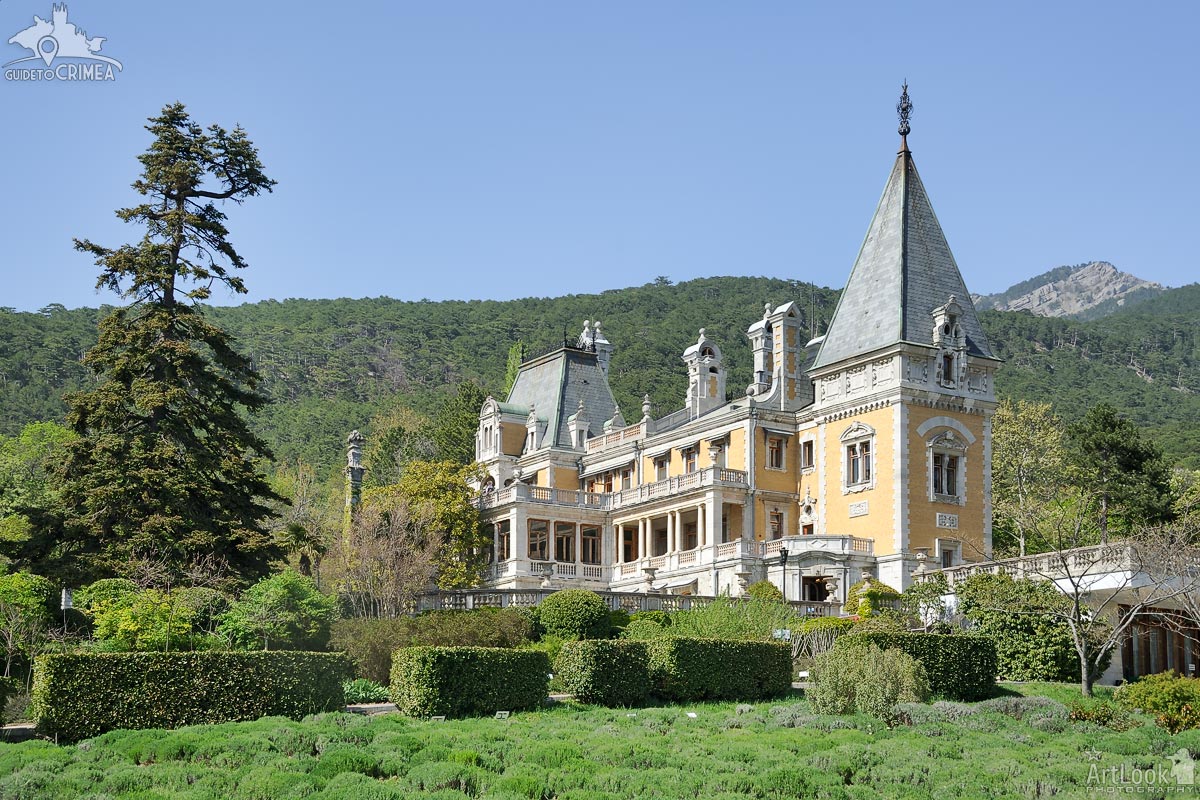
View of the Palace of Russian Emperor Alexander III in Massandra from local garden on a sunny spring day. Resembling a French chateau, the palace is situated 5 km North-East from Yalta in Crimean village Massandra that located on elevated and cliffy cape.
The castle originally built in 1881-1900 for Tsar Alexander III, but after his death in 1894, the palace in Massandra was finished in 1900 by his son and the last Russian Tsar, Nicolas II. This castle was used by Romanovs only as hunting lodge and the royal family never stayed for a night here, but during the Soviet times, Joseph Stalin decided to use it as his as his dacha in Crimea.
Photo #235 taken on May 02, 2017
| Album | Massandra Estate |
| Category | Architectural |
| Taken | May 2, 2017 |
| Uploaded | October 29, 2019 |

Sculpture of a woman-sphinx with a ball at the facade of Massandra Palace located on the Southern coast of Crimea
Front angle view of a sculpture of the woman-sphinx with a ball at Southern facade of Massandra Palace near Yalta, Crimea. The palace was built at the end of 19th century in the style of Louis XIII of France (French chateaux of the Renaissance) and belonged to Russian Emperor Alexander III.
Photo #060 taken on May 02, 2017
| Album | Massandra Estate |
| Category | Architectural |
| Taken | May 2, 2017 |
| Uploaded | October 22, 2019 |

Flowering standard pink rose-tree at the picturesque antique patio near the eastern facade of Massandra Palace in the background of the curved stonewall with fountains.
Photo #051 taken on August 13, 2019 during tour of Livadia Palace and Park with my dear clients from Hong Kong, Esther and Ricky on the 3rd day of the adventure trip “Discovering Crimea in 6 Days”.
| Album | Massandra Estate |
| Categories | Landscapes, Nature |
| Taken | August 13, 2019 |
| Uploaded | October 29, 2019 |
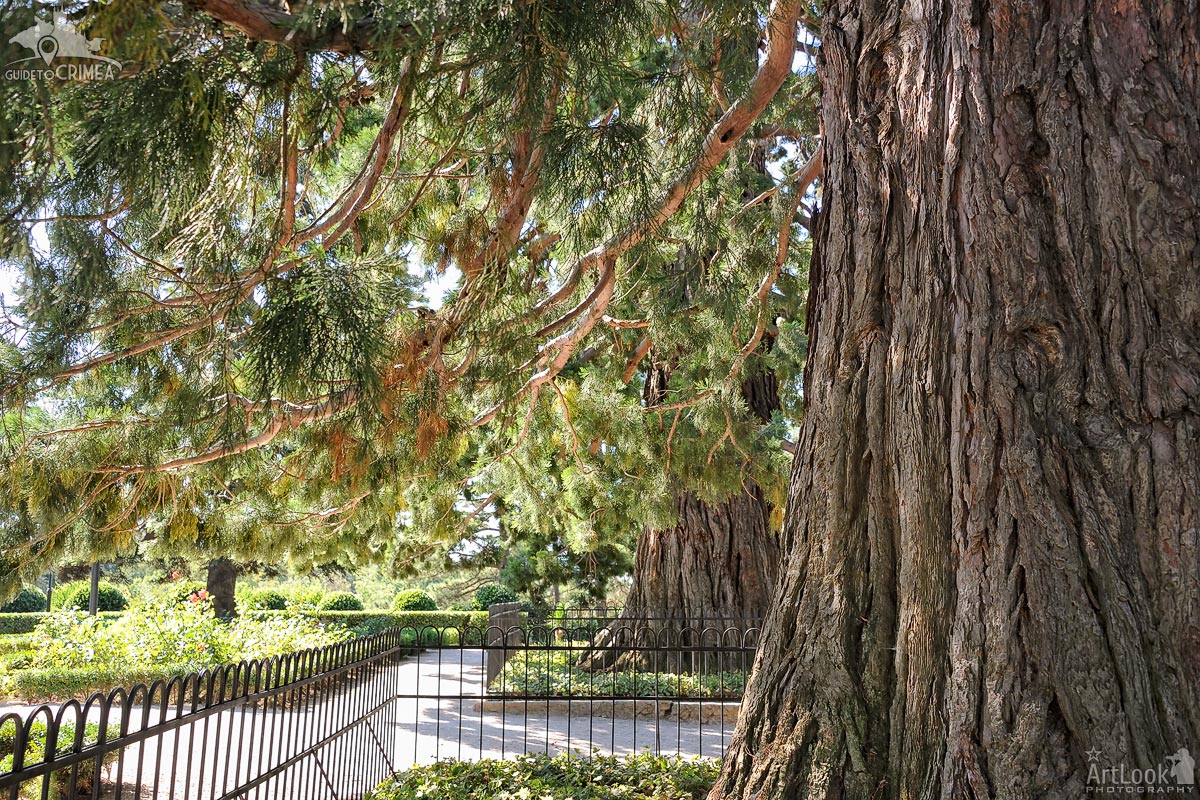
Under the huge branches of Sequoiadendron giganteum, evergreen coniferous tree of gigantic size in Massandra park. With branches resembling mammoth tusks, these sequoias also called Mammoth trees. The two giant trees were planted on the western facade of the Massandra Palace 130 years ago during the reconstruction of the residence of Emperor Alexander III according to the project of the famous architect Messmacher in the 1890s. In the present time, the trunk girth of the giant sequoias is about nine meters, and the height is about forty meters.
The first seeds of Sequoiadendron giganteum Nikitsky Botanical Garden (located in few kilometers from Massandra) received in 1840 from the former Russian colony Ross in California. Later, the giant sequoia dedron came to Europe from the South of Crimean peninsula.
Photo #005 taken on August 13, 2019 during visiting Massandra Palace with my dear clients from Hong Kong, Esther and Ricky on the 3rd day of the adventure trip “Discovering Crimea in 6 Days”.
| Album | Massandra Estate |
| Category | Nature |
| Taken | August 13, 2019 |
| Uploaded | October 25, 2019 |
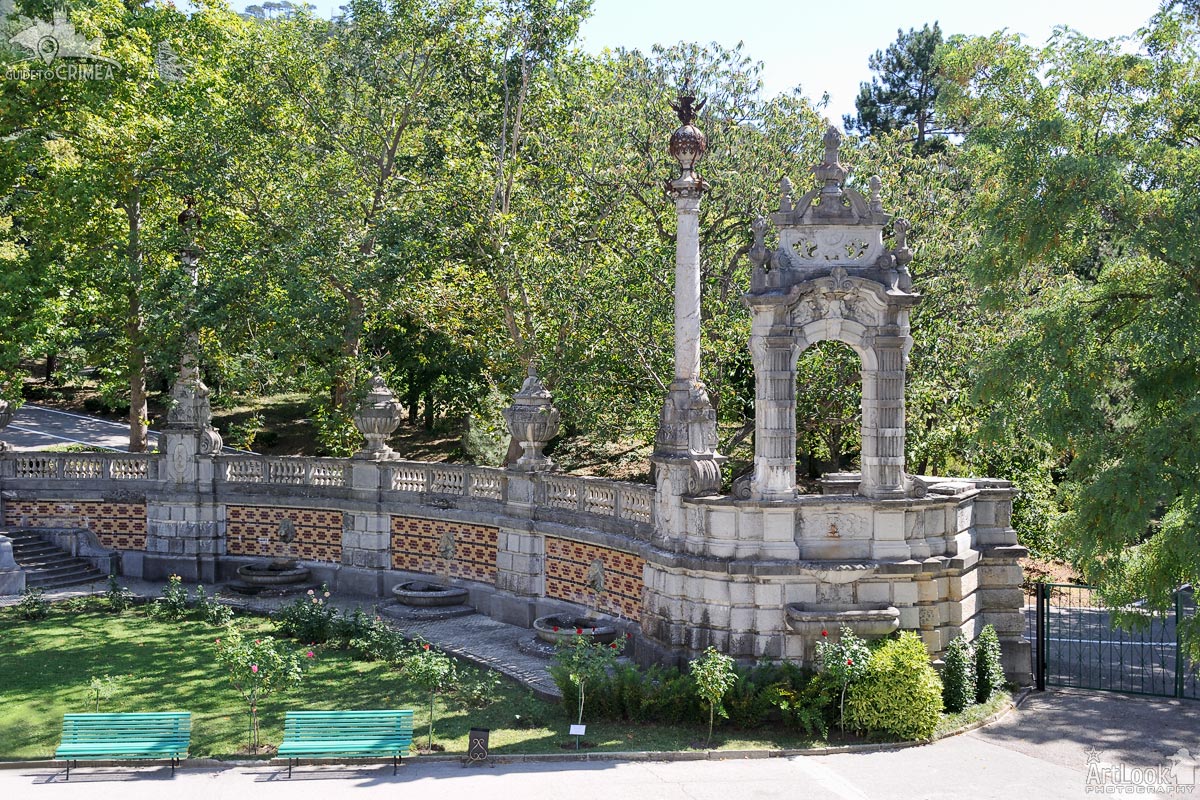
View from a second floor of the Massandra Palace on a part of the curved retaining wall with fountains decorated with colums and arches at the parade entrance gate into the Royal estate. The wall, columns and fountains were built when the estate belonged to Prince Vorontsov, the Governer of Novorossiya. The entrance gate was "guarded" by lions - sculptural castings (made in the workshops of the Academy of Arts in St. Petersburg) from the work of the famous French animal sculptor A.L. Bari (1796-1875). The entire retaining wall was decorated with majolica plates, red irrigation tiles. Six fountains with satyr and naiad macarons were mounted in it (these masks were replaced with masks of lions in Stalin times). By its architectural and artistic decision, this retaining wall organically entered the general palace and park ensemble.
Photo #120 taken on August 13, 2019 during the tour of Massandra Palace with my dear clients from Hong Kong, Esther and Ricky on the 3rd day of the adventure trip “Discovering Crimea in 6 Days”.
| Album | Massandra Estate |
| Category | Architectural |
| Taken | August 13, 2019 |
| Uploaded | October 30, 2019 |

Eastern facade of Massandra Palace in a cloudy Autumn day. Resembling a French chateau, the palace of Emperor Alexander III is situated 5 km North-East from Yalta in Crimean village Massandra that located on elevated and cliffy cape. The castle originally built in 1881-1900 for Tsar Alexander III, but after his death in 1894, the palace in Massandra was finished in 1900 by his son and the last Russian Tsar, Nicolas II. This castle was used by Romanovs only as a hunting lodge and the royal family never stayed for a night here, but during the Soviet times, Joseph Stalin decided to use it as his dacha in Crimea.
Photo #045 taken on September 14, 2013
| Album | Massandra Estate |
| Category | Architectural |
| Taken | September 14, 2013 |
| Uploaded | October 29, 2019 |
